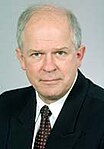Lithuanian parliamentary election, 1996
|
|
||||||||||||||||||||||||||||
|---|---|---|---|---|---|---|---|---|---|---|---|---|---|---|---|---|---|---|---|---|---|---|---|---|---|---|---|---|
|
||||||||||||||||||||||||||||
|
All 141 seats to the Seimas 71 seats were needed for a majority |
||||||||||||||||||||||||||||
|
||||||||||||||||||||||||||||
|
||||||||||||||||||||||||||||
Gediminas Vagnorius
Homeland Union
Parliamentary elections were held in Lithuania in two stages on 20 October and 10 November 1996. All 141 seats in the Seimas were up for election; 70 based on proportional party lists and 71 in single member constituencies. Where no candidate gained more than 50% of the vote on 20 October, a run-off was held on 10 November.
The first round of the elections was held concurrently with a referendum to amend Articles 55, 57 and 131 of the constitution, and a referendum on the use of proceeds from privatization. The second round was held concurrently with a referendum to amend Article 47 of the constitution. Due to a low turnout, none of the referendum questions succeeded in getting approval from at least 50% of registered voters.
Elections were won by the Homeland Union - Lithuanian Conservatives, which gained 70 seats, forming a coalition with second-place Lithuanian Christian Democratic Party. Homeland Union benefited from popular dissatisfaction with the ruling Democratic Labour Party of Lithuania, which had failed to reignite the economy and was plagued by financial scandals. Gediminas Vagnorius was subsequently appointed as the Prime Minister.
In his decree on 9 April 1996, the President of Lithuania Algirdas Brazauskas set the date of the elections to the Seimas for 20 October. Elections took place under a mixed electoral system, with 70 MPs elected on proportional party lists and 71 MPs in single member constituencies. Run-off elections were to be held on 10 November in constituencies where no candidate received at least 50% of the votes cast.
...
Wikipedia


